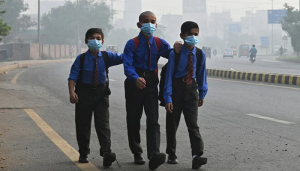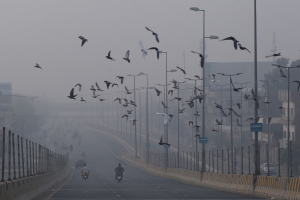Punjab’s Toxic Smog Crisis – A Public Health Emergency
Unprecedented air pollution levels grip Punjab, impacting public health, travel, and daily life amid an ongoing smog crisis.
As winter unfolds, Punjab, Pakistan, is experiencing an unprecedented smog crisis, with major cities like Lahore, Multan, and Faisalabad recording hazardous levels of air pollution. Smog, a deadly combination of smoke and fog intensified by pollutants, is now a recurrent issue in Pakistan, especially in Punjab, where agricultural practices, industrial emissions, and vehicular pollution converge. This season, the situation has worsened dramatically, with Lahore’s AQI reaching a record high of 1,165 in some areas. Such extreme levels pose an immediate threat to public health, mobility, and daily life.
Health Risks: The Silent Killer Lurking in the Air
The primary concern of the smog crisis is the impact on public health. With an AQI of over 300 considered hazardous, Lahore and nearby cities are experiencing levels three to five times this threshold. An AQI of 1,165 is a severe health emergency, exposing citizens to high levels of PM2.5, which can penetrate deep into the lungs and bloodstream, leading to respiratory and cardiovascular diseases.
Local hospitals report a significant increase in patients suffering from respiratory issues, asthma, eye irritation, and headaches. According to health experts, the immediate health risks are severe for children, the elderly, and individuals with pre-existing conditions. Dr. Irfan Javed from the Lahore Health Department notes, “Even short-term exposure to such high AQI levels can trigger respiratory distress, while long-term exposure increases the risk of chronic diseases, including lung cancer and heart conditions.”
Given the emergency, authorities have urged citizens to avoid outdoor activities and have advised mask-wearing for those who must venture outside. Schools have also been closed temporarily in several districts, including Lahore, to protect children from prolonged exposure to the hazardous air.
The Causes of Smog in Punjab
The toxic smog in Punjab results from a mix of factors, each contributing significantly to the crisis:
- Agricultural Crop Burning: Every autumn, farmers in Punjab and across the border in India burn rice stubble to clear their fields for the next planting season. While efficient, this method releases large amounts of smoke and particulate matter, which get trapped in the atmosphere and drift across regional boundaries. Despite government bans on crop burning, enforcement remains challenging, and many farmers lack affordable alternatives. This season, satellite data captured a high concentration of crop-burning incidents across both Indian and Pakistani Punjab, directly worsening the smog situation.
- Industrial Pollution: Punjab, especially cities like Lahore and Faisalabad, hosts numerous industrial areas where emissions from factories, brick kilns, and other industrial facilities contribute to pollution. A large portion of these facilities lack effective filtration systems, emitting high levels of sulfur dioxide, nitrogen oxides, and carbon monoxide. These pollutants not only reduce air quality but also form secondary particles that intensify smog when combined with atmospheric moisture.
- Vehicular Emissions: Rapid urbanization in Punjab has led to a substantial increase in vehicles on the road. Many vehicles, including public buses and trucks, run on substandard fuel or outdated engines that produce excessive smoke and harmful gases. Congestion in urban centers further compounds emissions, with major roads in Lahore and Multan frequently choked with traffic during rush hours.
- Open Waste Burning: Another lesser-known factor is the open burning of waste, including plastic and rubber, which releases toxic chemicals into the air. In cities like Faisalabad, where waste management infrastructure is limited, garbage fires are a common practice, worsening air pollution and compounding the health risks of smog.
- Weather and Geography: Punjab’s geographical location and seasonal weather patterns contribute to the persistence of smog. During winter, temperature inversions trap pollutants close to the ground, preventing them from dispersing and creating a “smog dome” over cities like Lahore. Wind patterns also play a role, as polluted winds from industrial zones and neighboring regions carry pollutants across boundaries.
The Government’s Response: Emergency Measures and Long-Term Goals
The Punjab government, recognizing the crisis, has declared smog a “calamity” and enacted several immediate and long-term measures:

- Green Lockdowns and Reduced Industrial Activity: In response to the crisis, authorities have imposed “green lockdowns” in Lahore’s most affected zones. Construction activities, known to produce large amounts of dust, have been restricted, and businesses relying on coal or wood are facing operational limits to minimize emissions. The lockdowns are an attempt to reduce pollution in high-risk areas and bring AQI levels down.
- Strict Penalties and Monitoring: The Punjab Environmental Protection Department has intensified inspections and is imposing hefty fines on violators of pollution control regulations. Drones are now deployed in agricultural areas to monitor crop-burning activities, while on-ground enforcement has led to thousands of fines issued to individuals, businesses, and vehicles in violation of emissions standards.
- Introduction of Work-from-Home Policies: To reduce the number of vehicles on the road, the government has encouraged a work-from-home policy for public and private sector employees. This measure is intended to alleviate road congestion, reduce vehicular emissions, and protect employees from exposure to hazardous air.
- Exploration of Artificial Rain and Technological Solutions: Artificial rain, a method used in other countries to improve air quality, is being explored as a potential solution to wash out pollutants from the atmosphere. Though costly, it could provide temporary relief. In addition, Punjab’s government is enhancing air quality monitoring with real-time data from sensor networks to better inform response efforts and public health advisories.
The Economic Cost of Smog
The economic consequences of the smog crisis are profound. Restricted visibility and hazardous air conditions have led to multiple highway closures and flight delays, disrupting logistics and business operations. Industries reliant on outdoor labor, such as construction, are experiencing delays, increasing project costs. Furthermore, tourism, which brings revenue to cities like Lahore with historical sites, is expected to decline as visitors are deterred by health risks and poor air quality. Health expenses are also soaring, with hospitals overwhelmed by respiratory cases and healthcare costs rising due to the high demand for treatment and preventive care.

The World Bank estimates that air pollution costs Pakistan nearly 6% of its GDP each year, and this season’s smog crisis underscores the economic toll of failing to address environmental issues. Experts argue that without a shift toward sustainable practices, these costs will continue to rise, hampering economic growth and public well-being.
Public Awareness and Community Action
As government measures roll out, public cooperation is crucial for mitigating the crisis. Awareness campaigns are educating citizens on protective measures such as wearing masks and limiting outdoor activities. Public engagement also includes promoting eco-friendly practices like tree planting and responsible waste disposal to reduce pollution at a grassroots level.
However, while awareness efforts are vital, citizens are also advocating for systemic change. Environmentalists, activists, and local organizations are urging the government to invest in renewable energy and cleaner public transportation. Furthermore, campaigns highlight the importance of phasing out outdated vehicle engines and enforcing strict emissions standards across industries.
A Call for Regional Cooperation
The smog crisis in Punjab is a regional issue, with pollution from crop-burning and industrial activity crossing borders. Collaboration between Pakistan and India is critical to formulating policies that can curb agricultural burning and control industrial emissions in both countries. Environmental think tanks propose joint efforts in research, technology sharing, and policy-making to combat air pollution. Cross-border initiatives could include early warning systems, shared satellite monitoring of crop-burning hotspots, and joint policy frameworks to limit emissions during the high-risk smog season.

The smog crisis in Punjab is a stark reminder of the need for immediate and long-term strategies to combat air pollution. While current emergency measures like lockdowns and fines are essential, they are only short-term solutions to a recurring issue. Sustainable urban planning, renewable energy adoption, and cross-border cooperation are key to addressing the root causes of pollution and protecting public health in the future.
Punjab’s air quality crisis highlights the urgency of tackling environmental issues in rapidly urbanizing regions. By investing in sustainable infrastructure and prioritizing environmental protection, Pakistan can work towards a cleaner, healthier future for all its citizens.

